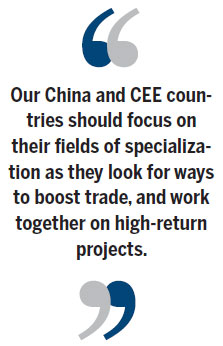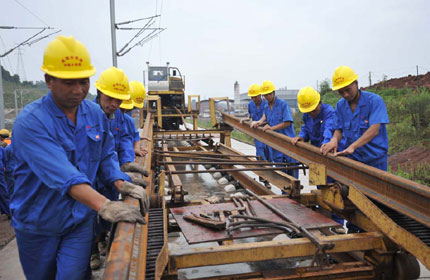Tapping into each other's strength
Updated: 2014-07-04 08:09
By Wang Wei (China Daily Europe)
|
|||||||||||
Closer ties between china and eastern europe could unlock huge potential for trade and investment
Sixteen countries in Central and Eastern Europe take up 1.3 million square kilometers and have a population of about 123 million, but their total trade with China is about the size of Italy's.
China's total investment in these 16 countries is less than its investment in Sweden. Their investment in China is smaller than that of Austria.
To change this situation, China and CEE countries should focus on their fields of specialization as they look for ways to boost trade, and work together on high-return projects.
But because these countries maintain close economic ties with Western Europe, the eurozone debt crisis has hampered external demand-driven economic progress. Bank liquidity is a problem and investment, consumption and credit have dropped in the CEE countries.
Foreign investors have started investing again in the region, but the scale has been lower than before the crisis. During the crisis, investment in Central and Eastern Europe was halved from 112 billion euros to 55 billion ($152 billion to $75 billion), while in 2010 the CEE countries attracted foreign investment of 60.9 billion euros, an increase of 9 percent from the previous year, according to the Vienna Institute for International Economic Studies.
Meanwhile, China's economic and trade relations with CEE countries have developed rapidly. In 2001, bilateral trade was only $4.3 billion. In 2011, China's trade with Romania alone surpassed that figure. That same year, China's trade with the 16 countries amounted to nearly $53 billion.

From 2001 to 2011, the volume of trade between China and the CEE region increased more than 27 percent annually.
As Central and Eastern European economies changed in recent decades, they formed a deep economic dependence on Western Europe. According to Anbound Consulting, a think tank for public policy in China, the leading and strategic industries of Eastern Europe are all under foreign control. Its dualistic economic structure meant its internal economy became highly dependent on foreign capital inflows. Since many eurozone economies are still struggling, it makes sense that the CEE region is looking to attract foreign capital from outside Europe.
Since the financial crisis, bilateral trade growth between China and Central and Eastern Europe has quickened. Chinese imports from Eastern Europe grew at an average annual rate of 30 percent. Two-way investment also has accelerated, and Chinese enterprises have invested in industries in the chemical, machinery, household appliances, telecommunications, automotive and new energy fields.
Investments are also expanding to the fields of agriculture, finance, science and technology. Their contribution to local economic growth and employment is significant, and joint infrastructure construction projects also have reaped positive results.
In April 2012, then premier Wen Jiabao met 16 CEE leaders in Warsaw, and announced initiatives that included the creation of a China and Central and Eastern European Countries' Cooperation Secretariat to take charge of communication and coordination, China's $10 billion line of credit to support cooperative projects with CEE countries, and a $500 million Investment Cooperation Fund. Wen was accompanied by a business delegation of 200 representatives of Chinese companies.
China also dispatched to the CEE countries a trade and investment promotion mission, set up a joint transportation network construction expert advisory committee, pledged 5,000 scholarships, and created a tourism alliance and a research fund.
Cultural exchanges have been an important driving force of bilateral relations. China and Eastern European countries have 37 pairs of sister provinces and states, and 58 pairs of sister cities.
In Eastern European countries, more and more people are learning Chinese - Confucius Institutes and Confucius Classrooms have grown to more than 58 in the region.
Because the CEE countries generally have high quality labor, the cost of investment is low compared to other areas. The laws and regulations are relatively sound. There is a great need for roads, railways, ports, power plants and other infrastructure construction, which makes those good areas for Chinese to expand.
CEE countries are solid in such areas as agriculture, machinery manufacturing, energy, and food processing. They have their own specialized strong points and technological products, which offers great potential for the region's products to enter the Chinese market, and makes expansion of exports to China probable.
The author is a researcher at the China Institute of International Studies.
(China Daily European Weekly 07/04/2014 page9)
Today's Top News
Gambling costs World Cup fans their lives
US supports Ukraine's decision to suspend ceasefire
It's all about making a spectacle
China likely to see 7.5% growth in second quarter
Palace Museum feeling the squeeze of visitors
Myanmar pagoda replica given to China
US sends 300 more troops to Iraq over concerns
Hong Kong at the crossroads
Hot Topics
Lunar probe , China growth forecasts, Emission rules get tougher, China seen through 'colored lens', International board,
Editor's Picks

|

|

|

|

|

|





